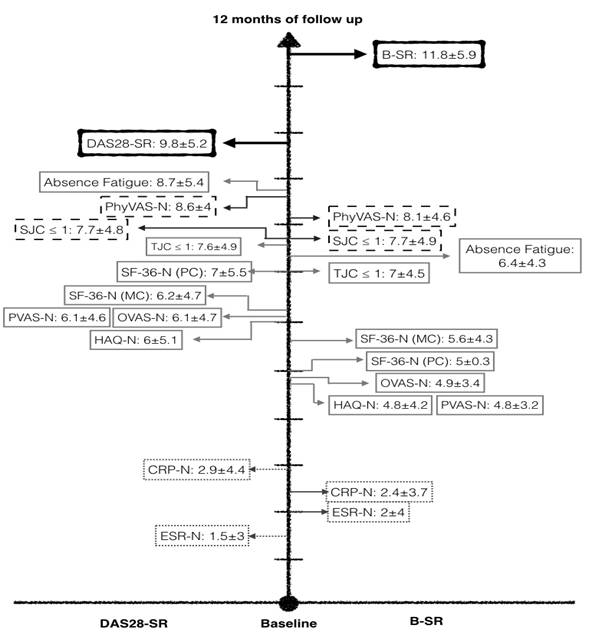Session Information
Session Type: ACR Poster Session A
Session Time: 9:00AM-11:00AM
Background/Purpose: Sustained remission (SR) is the most desirable status in patients with rheumatoid arthritis (RA). For adoption by patients, SR should reflect symptom´s resolution and impact patient-report-outcomes (PRO). The study was performed in an inception cohort of recent-onset RA, initiated in 2004. Objectives of the study were to describe PRO from patients who achieved SR for the first time, as well as the proportion of those patients who achieved PRO norms, and to describe the pattern of PRO´s normalization.
Methods: In November 2016, the cohort had 145 patients with ≥30 months of follow-up, with complete and regular rheumatic evaluations that additionally included a patient-pain visual analogue scale (PVAS), a patient-overall disease-VAS (OVAS), the health assessment questionnaire (HAQ), the Short-Form 36v2 Survey (SF-36) and fatigue assessment. First SR was defined according to DAS28 cut-offs (DAS28-SR) and to the ACR/EULAR 2011 Boolean definition (B-SR), if maintained for at least 12 months. The dependent t test and Mc Nemar´s tests were used. The study was approved by IRB and written informed consent was obtained from all the patients.
Results: At cohort inclusion, patients were primarily middle-aged female with a high frequency of auto-antibodies. Up to SR, 98% of the patients were on traditional DMARDs and 37-42% were receiving combined low doses of corticosteroids.
An increased number of patients achieved DAS28-SR compared to B-SR (78 vs. 63 patients, respectively). In addition, follow-up to DAS28-SR was shorter than to B-SR, and the duration of DAS28-SR was longer than the duration of B-SR (p≤0.03 for both).
In general, at SR (either DAS28-SR or B-SR) patients had PRO proxy to normal values (PRO-N); the percentage of patients with PRO-N varied from 97% for HAQ, but decreased to 50% for absence of fatigue.
In SR patients, we calculated (mean±SD) months of follow-up to achieve each particular PRO-N, and to achieve values within the normal range of erythrocyte sedimentation rate (ESR) and C reactive protein (CRP) and of overall-disease-physician-VAS. In DAS28-SR patients, normalization of ESR and CRP was detected at 1.5 and 2.9 months from baseline, respectively, followed by HAQ-N, PVAS-N, OVAS-N, SF-36-N (achieved between 6 and 7 months of follow-up); absence of fatigue was detected late, at 8.7 months of follow-up, similar to DAS28-SR, which was achieved at 9.8 months. A similar pattern was observed in B-SR patients (Figure. Pattern of outcome normalization).
Conclusion: At SR, RA patients achieved PRO proxy to normal values although the percentage of patients with PRO-N varied depending on each particular outcome. We identified a particular temporal pattern of outcome normalization. PRO provide unique information that cannot be collected from a physician and aid to complete the clinical picture of RA patients in SR.
Figure.
To cite this abstract in AMA style:
Contreras-Yáñez I, Guaracha G, Sifuentes-Cantú C, Pascual-Ramos V. The Impact of Rheumatoid Arthritis-Sustained Remission on Patient´s Reported Outcomes Differs Accordingly to Each Particular Outcome [abstract]. Arthritis Rheumatol. 2017; 69 (suppl 10). https://acrabstracts.org/abstract/the-impact-of-rheumatoid-arthritis-sustained-remission-on-patients-reported-outcomes-differs-accordingly-to-each-particular-outcome/. Accessed .« Back to 2017 ACR/ARHP Annual Meeting
ACR Meeting Abstracts - https://acrabstracts.org/abstract/the-impact-of-rheumatoid-arthritis-sustained-remission-on-patients-reported-outcomes-differs-accordingly-to-each-particular-outcome/

